Unsupervised Mitral Valve Tracking for Disease Detection in Echocardiogram Videos
Abstract
1. Introduction
2. Proposed Method
2.1. Otsu’s Thresholding
2.2. Contour and Atrial Centroid Estimation
| Algorithm 1: Recursive Estimation of the Closed Boundary of the Left Atrium |
|
2.3. Creating Prongs
2.4. Estimating Movement of Mitral Valve
2.5. Disease Estimation
3. Numerical Tests
3.1. Effects of Varying Values of Parameters
3.1.1. Number of Prongs
3.1.2. Cone Angle of Prongs
3.1.3. Size of Box (Accuracy)
3.1.4. Size of Box (Elapsed Time)
3.1.5. Contour Size (Accuracy)
3.1.6. Contour Size (Elapsed Time)
3.1.7. Open/Close Threshold
3.1.8. Transition Threshold
3.1.9. Step Size (Accuracy)
3.1.10. Step Size (Elapsed Time)
3.2. Computational Complexity
3.3. Comparison with Other Methods
4. Conclusions
Author Contributions
Funding
Acknowledgments
Conflicts of Interest
References
- Widmaier, E.P.; Raff, H.; Strang, K.T. Cardiovascular Physiology. In Vander’s Human Physiology: The Mechanisms of Body Function, 13rd ed.; McGraw Hill Education: New York, NY, USA, 2014; p. 378. [Google Scholar]
- Hołda, M.K.; Sanchez, J.D.Z.; Bateman, M.G.; Iaizzo, P.A. Right atrioventricular valve leaflet morphology redefined: Implications for transcatheter repair procedures. JACC Cardiovasc. Interv. 2019, 12, 169–178. [Google Scholar] [CrossRef] [PubMed]
- Krawczyk-Ożóg, A.; Hołda, M.K.; Sorysz, D.; Koziej, M.; Siudak, Z.; Dudek, D.; Klimek-Piotrowska, W. Morphologic variability of the mitral valve leaflets. J. Thorac. Cardiovasc. Surg. 2017, 154, 1927–1935. [Google Scholar] [CrossRef] [PubMed]
- Krawczyk-Ożóg, A.; Hołda, M.K.; Bolechała, F.; Siudak, Z.; Sorysz, D.; Dudek, D.; Klimek-Piotrowska, W. Anatomy of the mitral subvalvular apparatus. J. Thorac. Cardiovasc. Surg. 2018, 155, 2002–2010. [Google Scholar] [CrossRef] [PubMed]
- Agabegi, E.D.; Agabegi, S.S. Chap. 1: Disease of the Cardiovascular System/Section: Valvular Heart Disease. In Step-Up to Medicine, Step-Up Series; Lippincott Williams & Wilkins: Philadelphia, PA, USA, 2008; Chapter 1. [Google Scholar]
- Otto, C.M. Normal Anatomy and Flow Patterns on Transthoracic Echocardiography. In Textbook of Clinical Echocardiography, 5th ed.; Elsevier Health Sciences: Philadelphia, PA, USA, 2013; pp. 31–44. [Google Scholar]
- Martin, S.; Daanen, V.; Chavanon, O.; Troccaz, J. Fast Segmentation of the Mitral Valve Leaflet in Echocardiography. In Proceedings of the International Workshop on Computer Vision Approaches to Medical Image Analysis, Graz, Austria, 12 May 2006; Springer: Berlin/Heidelberg, Germany, 2006. [Google Scholar]
- Yu, L.; Guo, Y.; Wang, Y.; Yu, J.; Chen, P. Segmentation of Fetal Left Ventricle in Echocardiographic Sequences Based on Dynamic Convolutional Neural Networks. IEEE Trans. Biomed. Eng. 2017, 64, 1886–1895. [Google Scholar] [CrossRef]
- Minaee, S.; Boykov, Y.; Porikli, F.; Plaza, A.; Kehtarnavaz, N.; Terzopoulos, D. Image segmentation using deep learning: A survey. arXiv 2020, arXiv:2001.05566. [Google Scholar]
- Chandra, V.; Sarkar, P.G.; Singh, V. Mitral Valve Leaflet Tracking in Echocardiography using Custom Yolo3. Procedia Comput. Sci. 2020, 171, 820–828. [Google Scholar] [CrossRef]
- Minaee, S.; Wang, Y. An ADMM approach to masked signal decomposition using subspace representation. IEEE Trans. Image Process. 2019, 28, 3192–3204. [Google Scholar] [CrossRef]
- Kass, M.; Witkin, A.; Terzopoulos, D. Snakes: Active Contour Models. Int. Comput. Vis. 1988, 1, 321–331. [Google Scholar] [CrossRef]
- Liu, X.; Cheung, Y.; Peng, S.; Peng, Q. Automatic Mitral Valve Leaflet Tracking in Echocardiography via Constrained Outlier Pursuit and Region Scalable Active Contours. Neurocomputing 2014, 144, 47–57. [Google Scholar] [CrossRef]
- Sultan, M.S.; Martins, N.; Veiga, D.; Ferreira, M.J.; Coimbra, M. Tracking of the Anterior Mitral Leaflet in Echocardiographic Sequences Using Active Contours. In Proceedings of the 38th Annual International Conference of the IEEE Engineering in Medicine and Biology Society (EMBC), Orlando, FL, USA, 16–20 August 2016. [Google Scholar]
- Sultan, M.S.; Martins, N.; Costa, E.; Veiga, D.; Ferreira, M.J.; Mattos, S.; Coimbra, M.T. Virtual M-Mode for Echocardiography: A New Approach for the Segmentation of the Anterior Mitral Leaflet. IEEE J. Biomed. Health Inform. 2019, 23, 305–313. [Google Scholar] [CrossRef]
- Zhou, X.; Yang, C.; Yu, W. Automatic Mitral Leaflet Tracking in Echocardiography by Outlier Detection in the Low-Rank Representation. In Proceedings of the IEEE Conference on Computer Vision and Pattern Recognition, Washington, DC, USA, 16 June 2012; pp. 972–979. [Google Scholar]
- Schneider, R.; Perrin, D.; Vasilyev, N.; Marx, G.; de Nido, P.; Howe, R. Mitral Annulus Segmentation from 3-D Ultrasound Using Graph Cuts. IEEE Trans. Med. Imaging 2010, 29, 1676–1687. [Google Scholar] [CrossRef]
- Pouch, A.M.; Wang, H.; Takabe, M.; Jackson, B.M.; Gorman, J.H., III; Gorman, R.C.; Yushkevich, P.A.; Sehgal, C.M. Fully Automatic Segmentation of the Mitral Leaflets in 3D Transesophageal Echocardiographic Images Using Multi-Atlas Joint Label Fusion and Deformable Medial Modeling. Med. Image Anal. 2014, 18, 118–129. [Google Scholar] [CrossRef] [PubMed]
- Tautz, L.; Walczak, L.; Georgii, J.; Jazaerli, A.; Vellguth, K.; Wamala, I.; Hennemuth, A. Combining position-based dynamics and gradient vector flow for 4D mitral valve segmentation in TEE sequences. Int. J. Comput. Assist. Radiol. Surg. 2020, 15, 119–128. [Google Scholar] [CrossRef] [PubMed]
- Sørensen, K.; Schmidt, S.E.; Sørensen, P.L.; Korsager, A.S.; Melgaard, J.; Søgaard, P.; Struijk, J.J. Automatic segmentation of mitral leaflet movement in Doppler Tissue M-Mode ultrasound. In Proceedings of the Computing in Cardiology Conference (CinC), Vancouver, BC, Canada, 11–14 September 2016; pp. 1–4. [Google Scholar]
- Otsu, N. A Threshold Selection Method from Gray-Level Histograms. IEEE Trans. Syst. Man Cybern. 1979, 9, 62–66. [Google Scholar] [CrossRef]
- Ghuneim, A.G. Contour Tracing. Available online: http://www.imageprocessingplace.com/downloads_V3/root_downloads/tutorials/contour_tracing_Abeer_George_Ghuneim/moore.html (accessed on 15 April 2020).
- Carabello, B.A. Modern Management of Mitral Stenosis. Circulation 2005, 112, 432–437. [Google Scholar] [CrossRef]
- Hayek, E.; Gring, C.N.; Griffin, B.P. Mitral Valve Prolapse. Lancet 2005, 365, 507–518. [Google Scholar] [CrossRef]
- Boykov, Y.; Veksler, O.; Zabih, R. Efficient Approximate Energy Minimization via Graph Cuts. IEEE Trans. Pattern Anal. Mach. Intell. 2001, 20, 1222–1239. [Google Scholar] [CrossRef]
- Kolmogorov, V.; Zabih, R. What Energy Functions can be Minimized via Graph Cuts? IEEE Trans. Pattern Anal. Mach. Intell. 2004, 26, 147–159. [Google Scholar] [CrossRef] [PubMed]
- Boykov, Y.; Kolmogorov, V. An Experimental Comparison of Min-Cut/Max-Flow Algorithms for Energy Minimization in Vision. IEEE Trans. Pattern Anal. Mach. Intell. 2004, 26, 1124–1137. [Google Scholar] [CrossRef]
- Bagon, S. Matlab Wrapper for Graph Cut. Available online: https://github.com/shaibagon/GCMex (accessed on 20 April 2020).
- Jumb, V.; Sohani, M.; Shrivas, A. Color image segmentation using K-means clustering and Otsu’s adaptive thresholding. Int. J. Innov. Technol. Explor. Eng. 2014, 3, 72–76. [Google Scholar]
- Abdel-Nasser, M.; Melendez, J.; Moreno, A.; Omer, O.A.; Puig, D. Breast tumor classification in ultrasound images using texture analysis and super-resolution methods. Eng. Appl. Artif. Intell. 2017, 59, 84–92. [Google Scholar] [CrossRef]
- Yu, Y.; Acton, S.T. Speckle reducing anisotropic diffusion. IEEE Trans. Image Process. 2002, 11, 1260–1270. [Google Scholar] [PubMed]
- Speckle-Reducing-Anisotropic-Diffusion-SRAD. Available online: https://github.com/Xingorno/Speckle-Reducing-Anisotropic-Diffusion-SRAD (accessed on 29 July 2020).
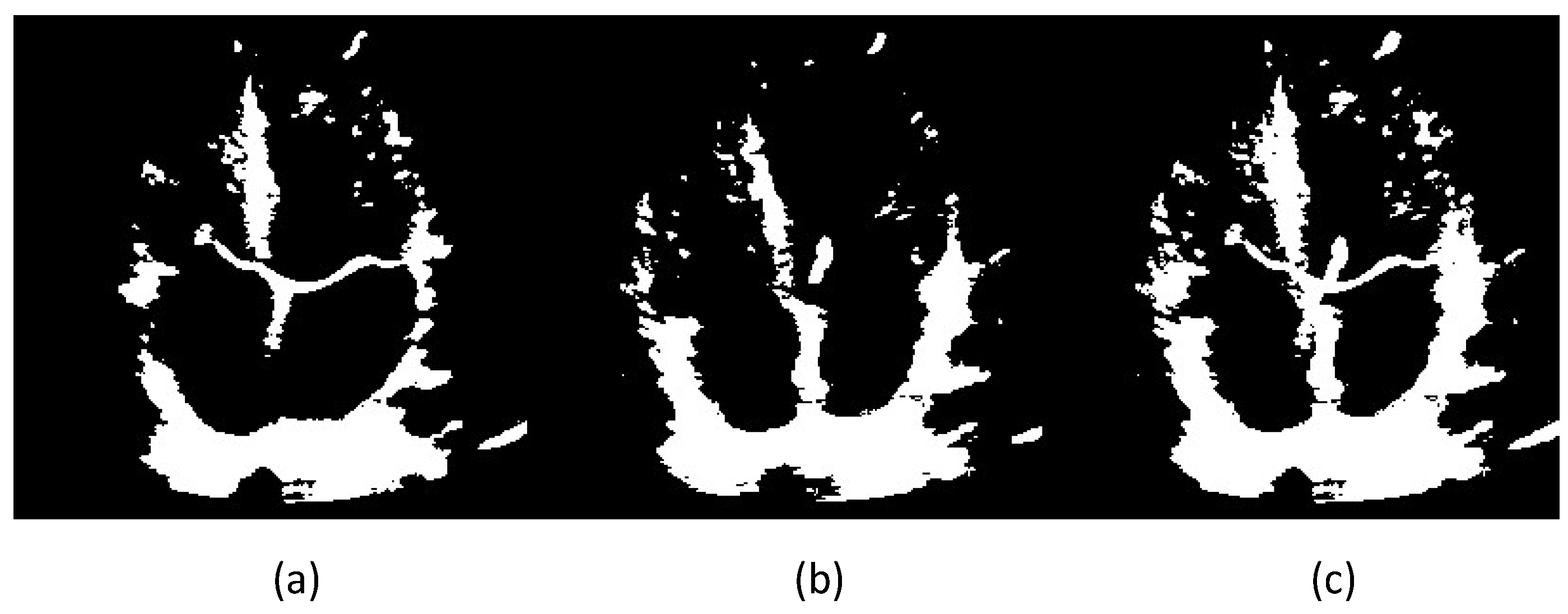
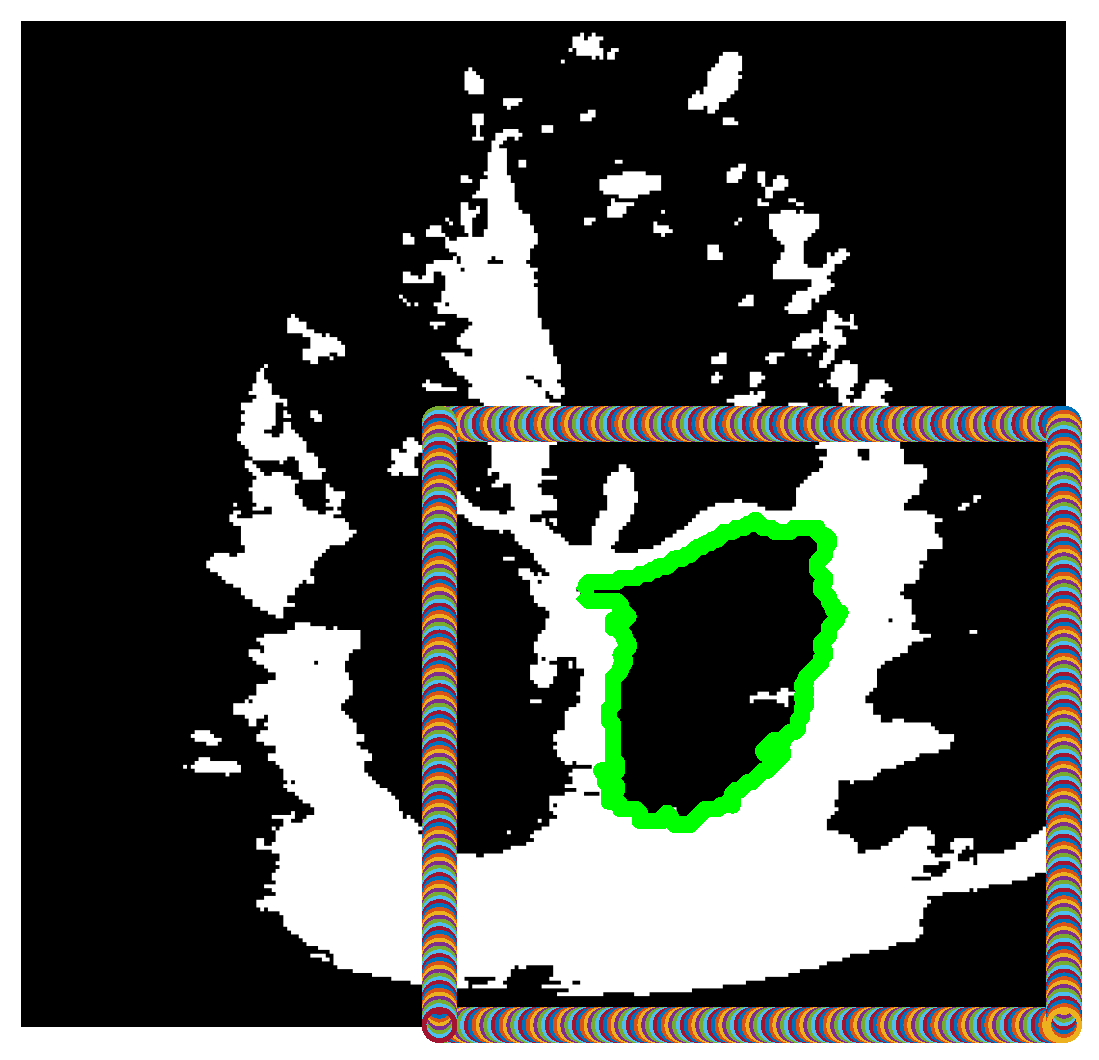
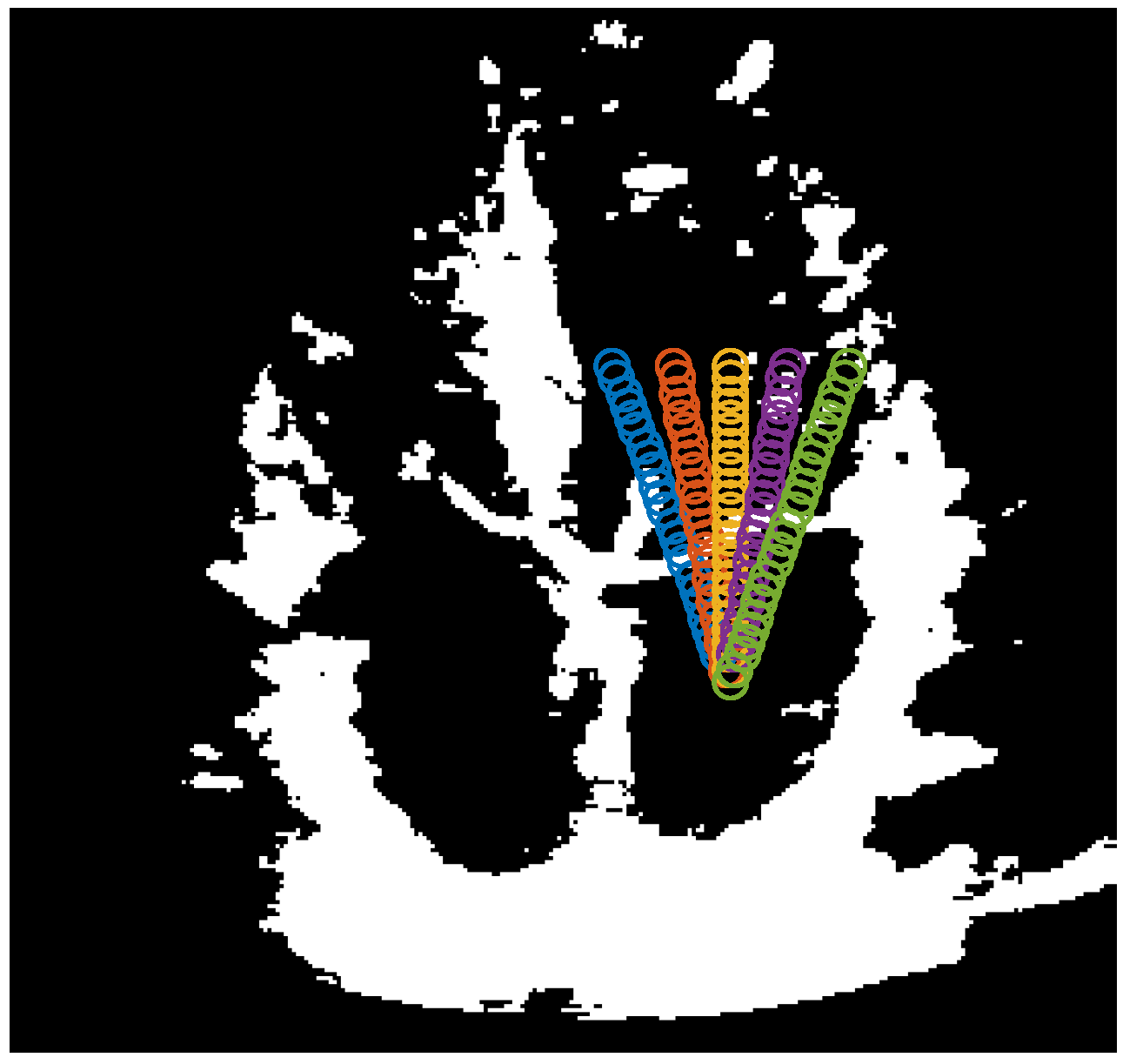
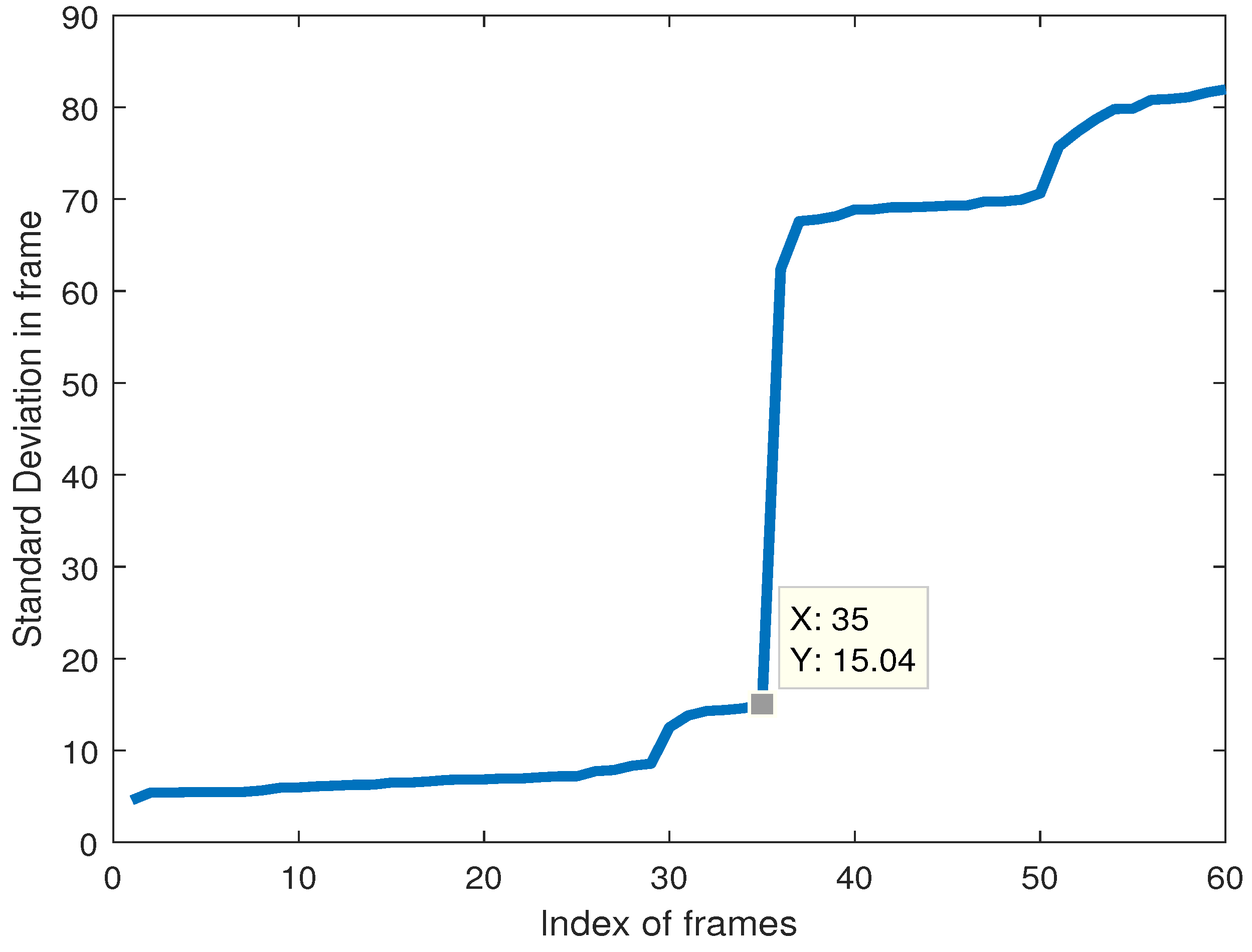

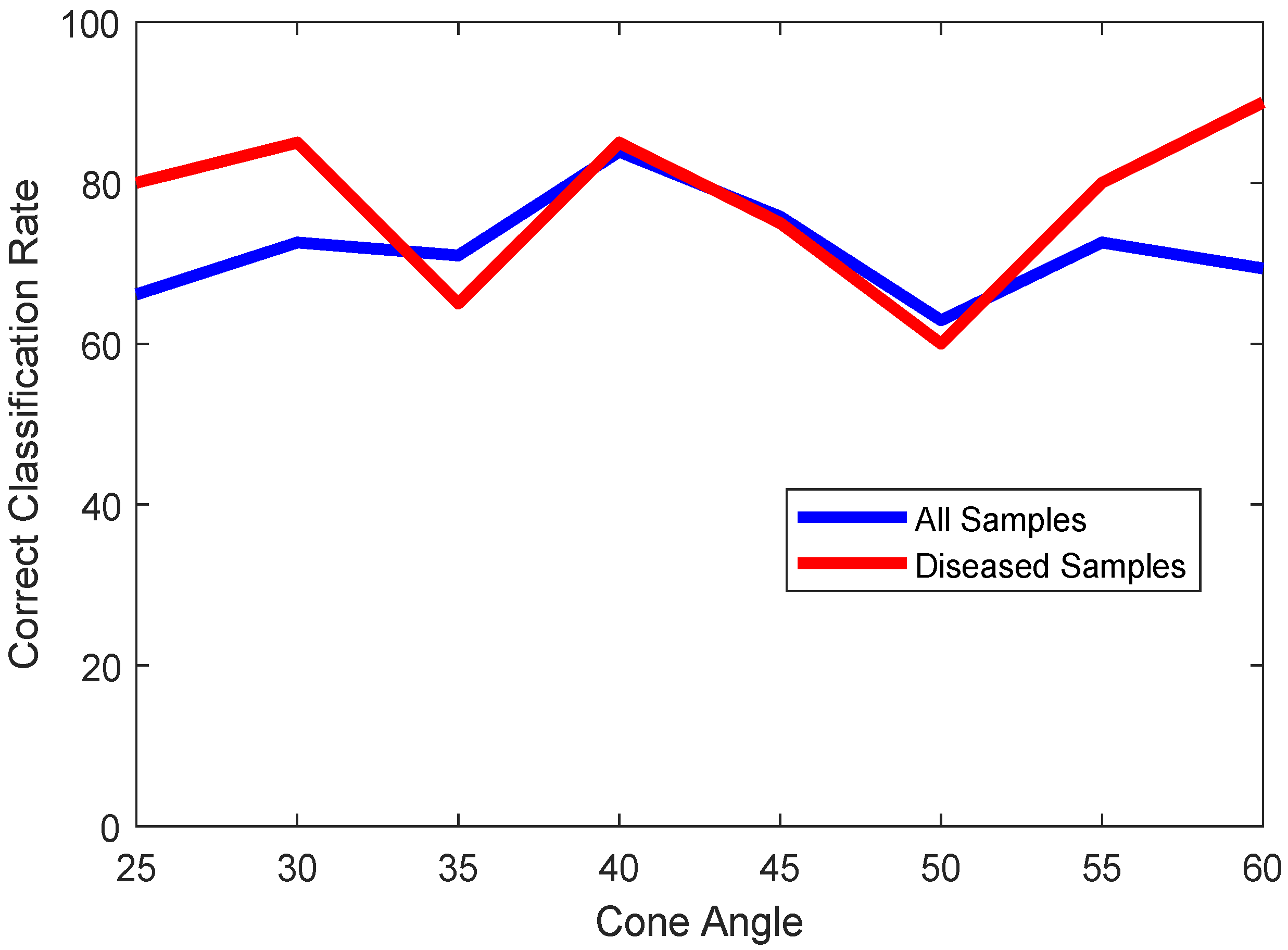
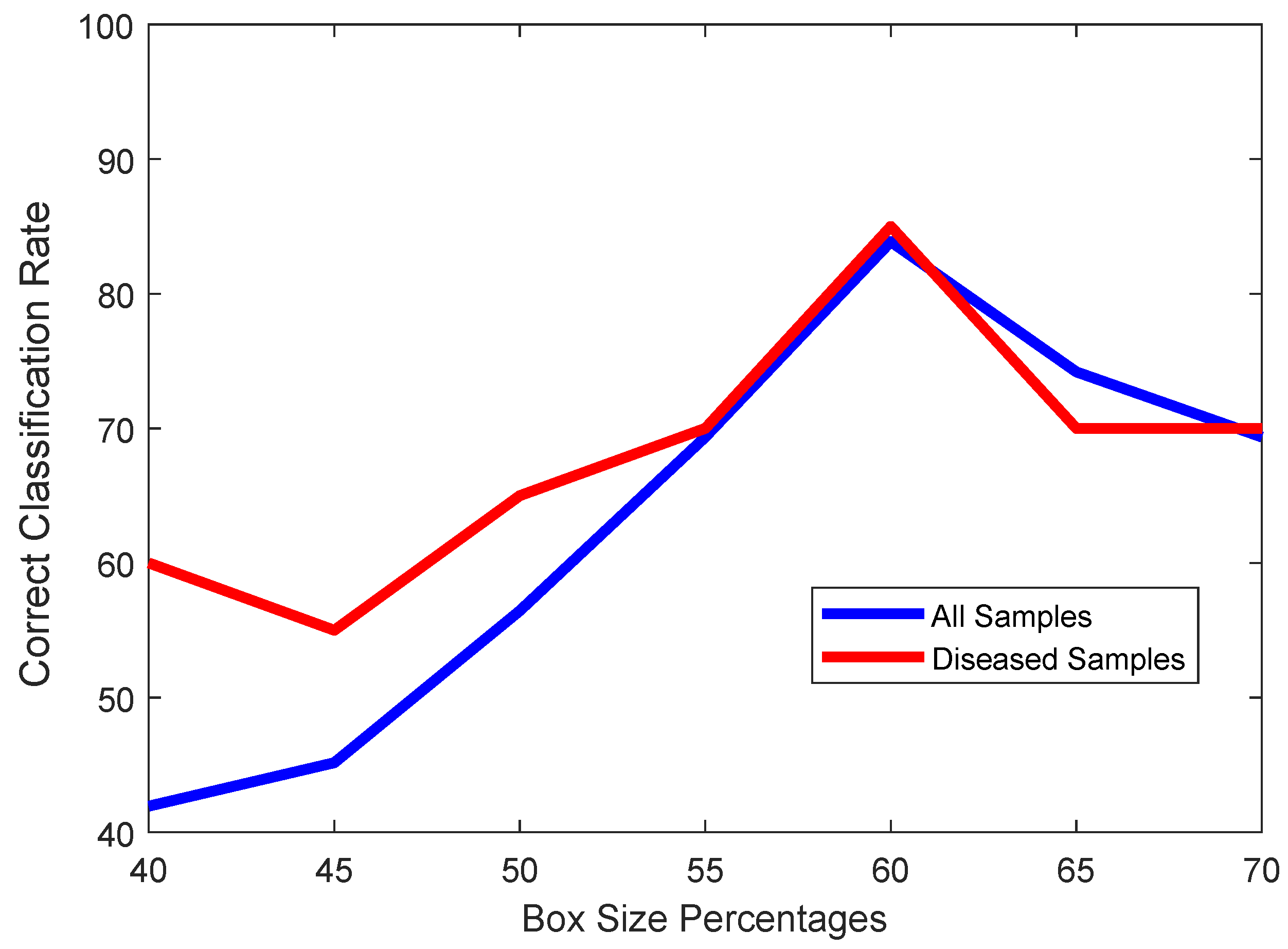


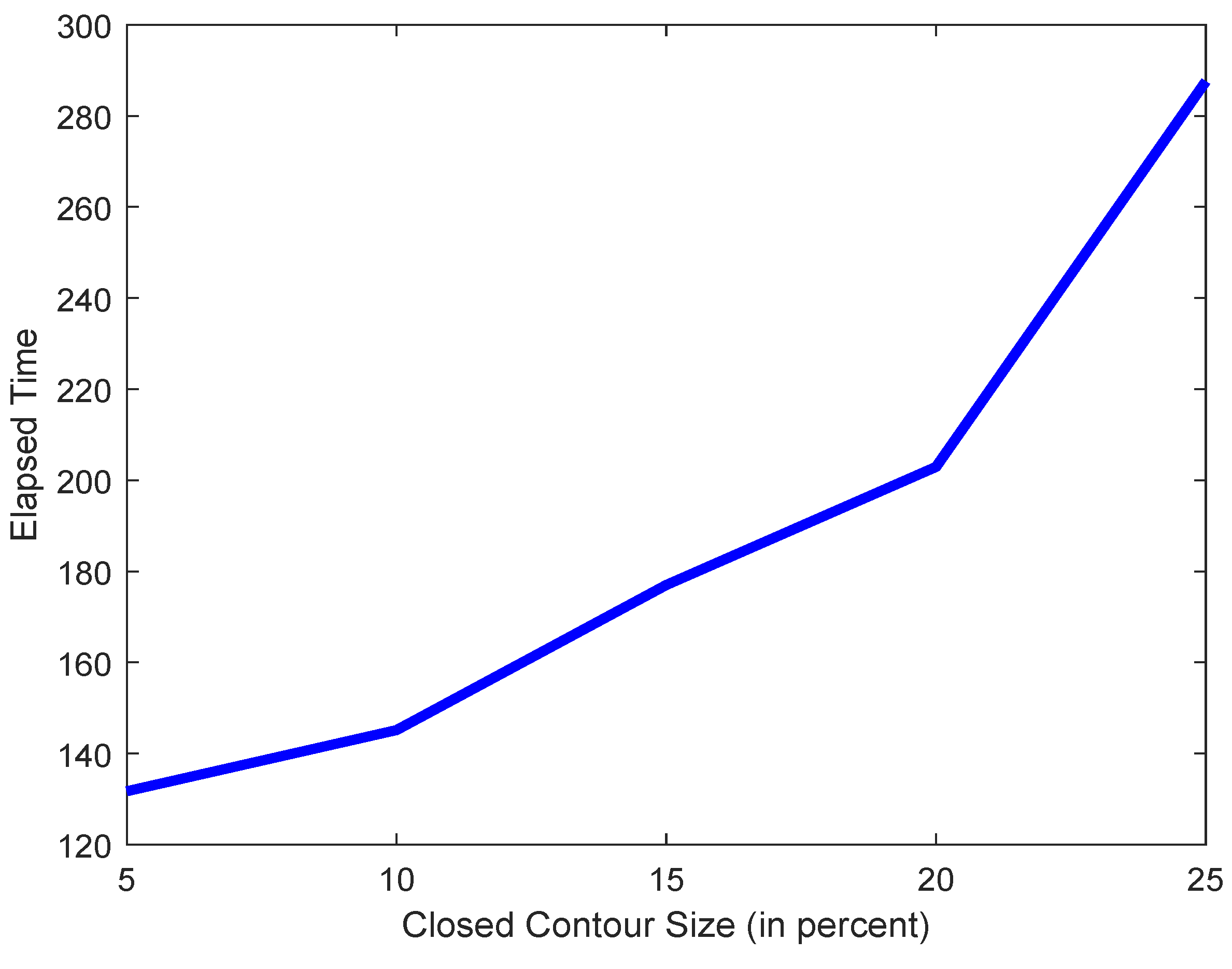
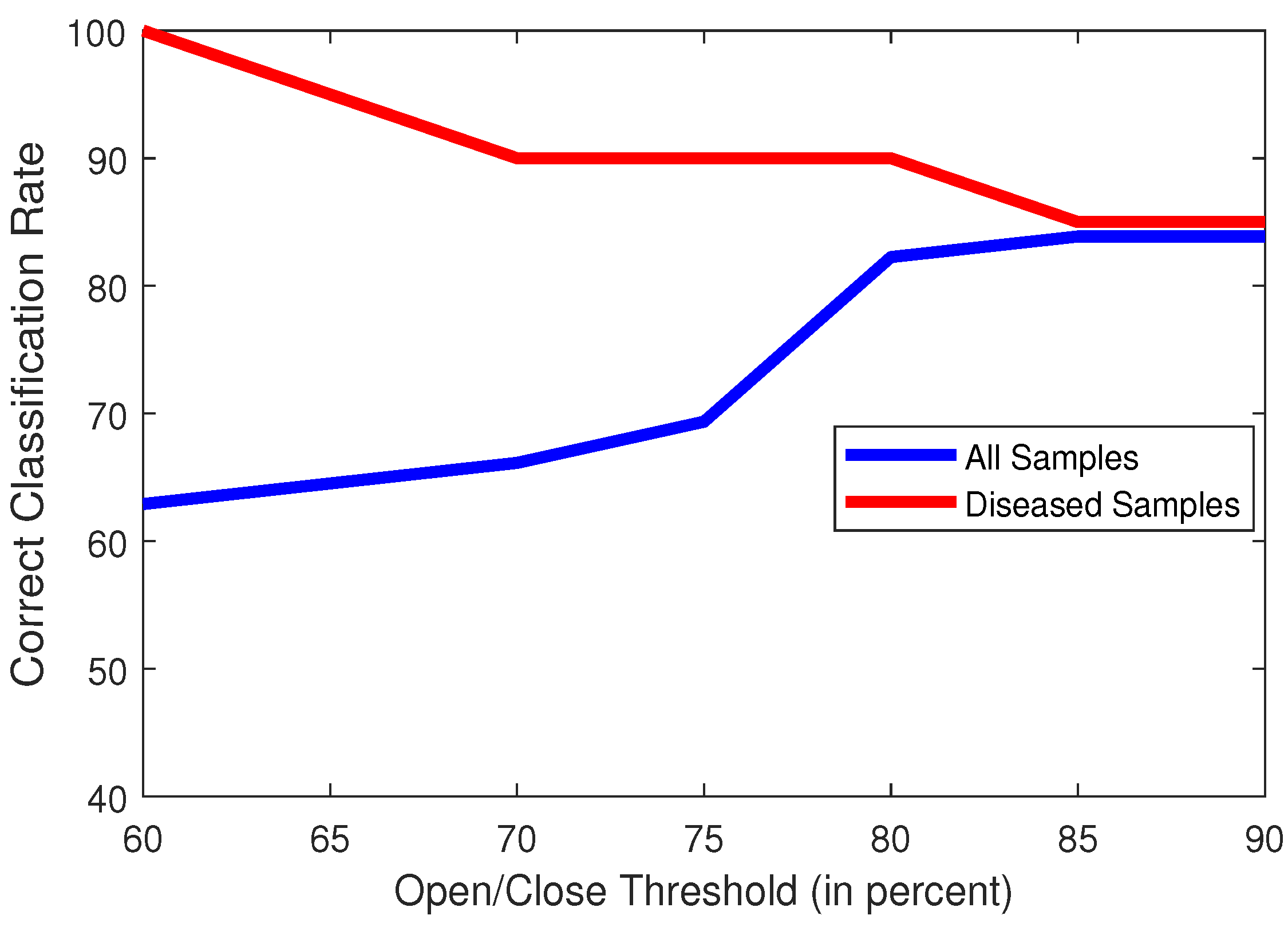

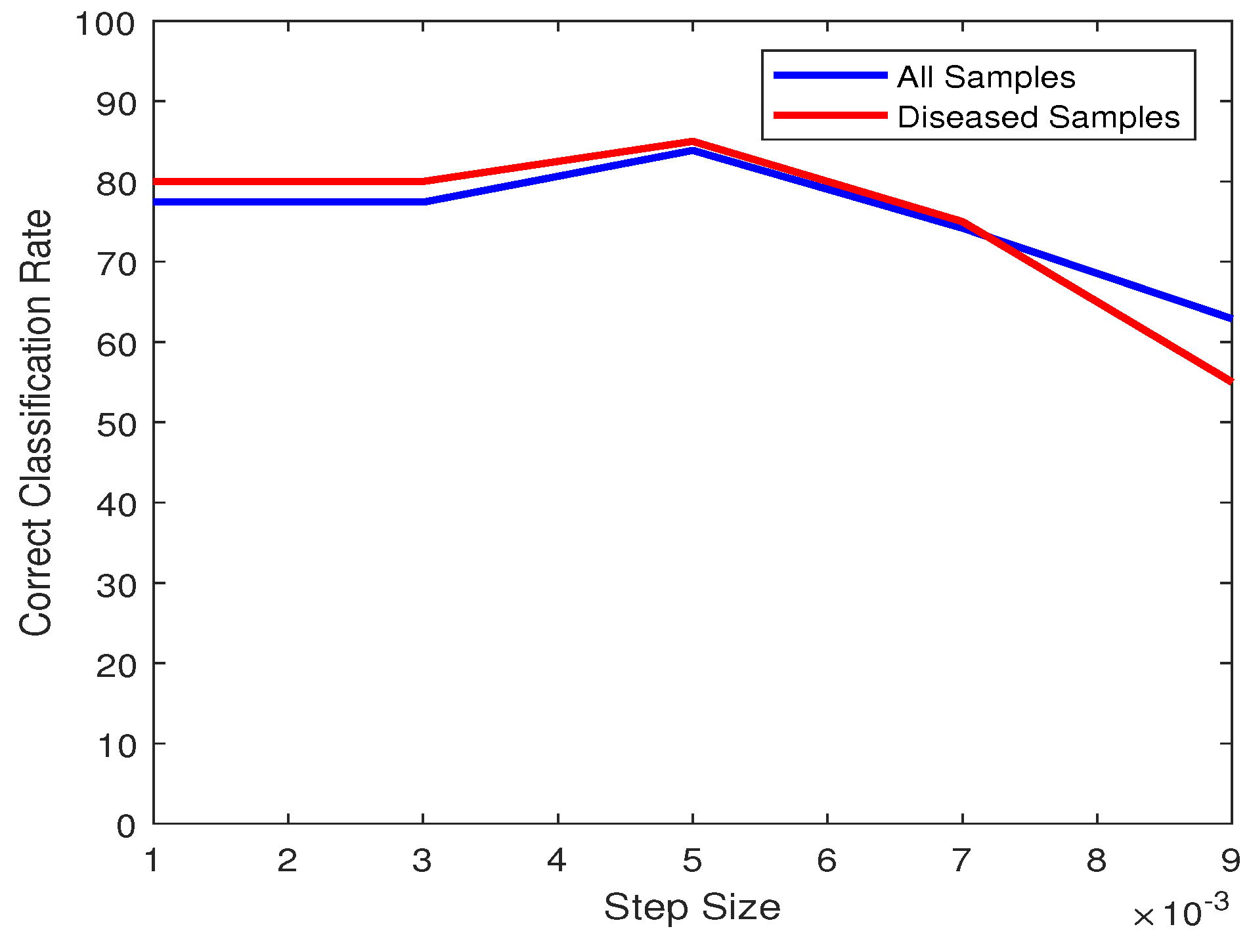
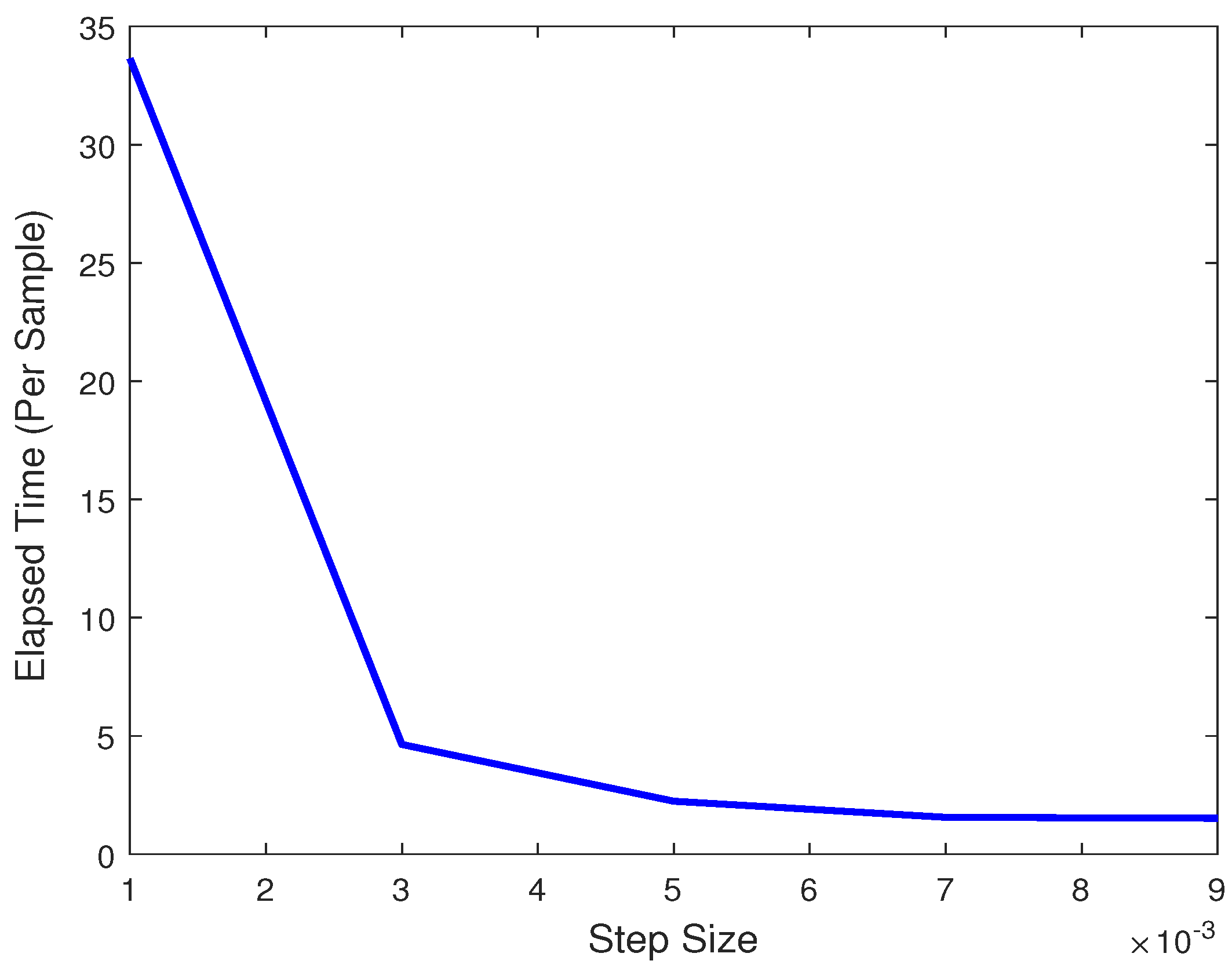
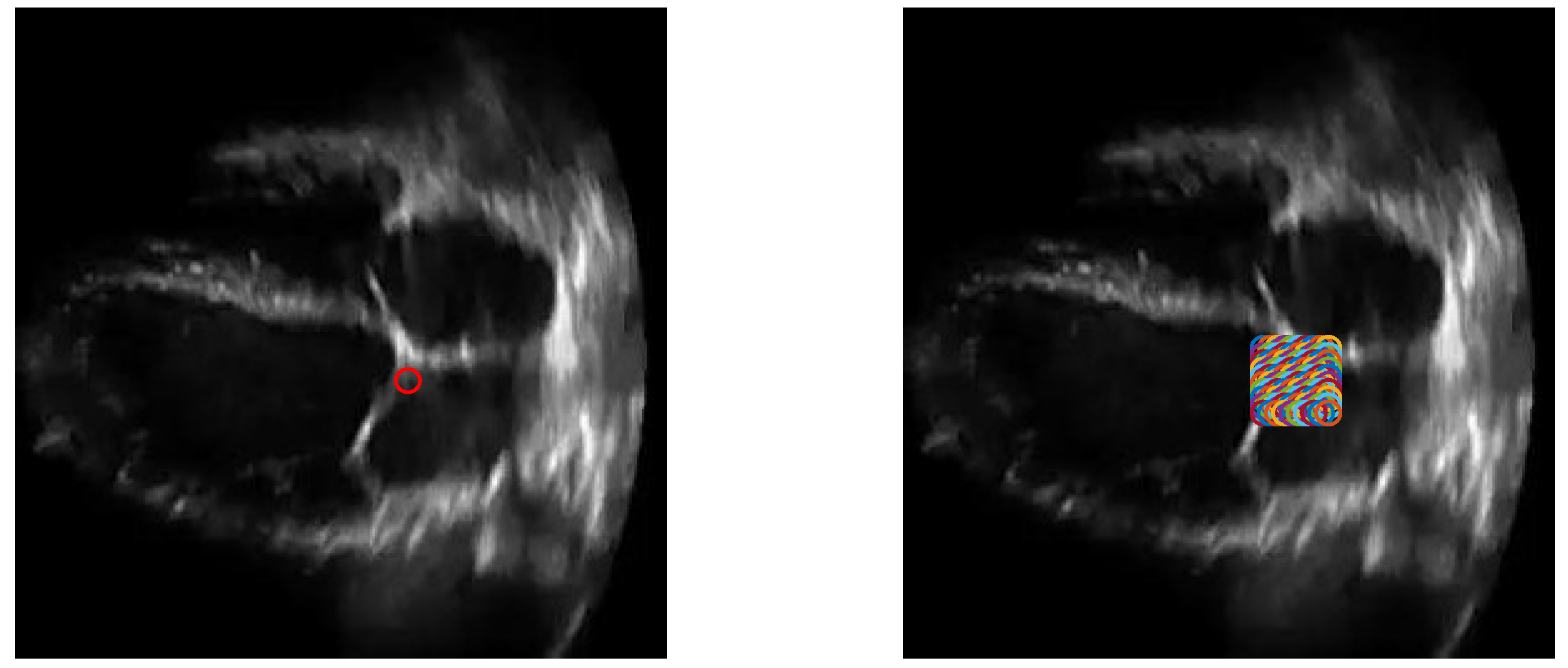
| Test Parameters | Proposed Method | VM—Mode (with Advantage) | VM—Mode (without Advantage) | LRRGC | KMOtsu | BUSRD |
|---|---|---|---|---|---|---|
| % of Correct Classification (All) | 83.87 | 64.71 | 63.27 | 32.26 | 27.42 | 61.29 |
| % of Correct Classification (Diseased) | 85.00 | 0 | 0 | 95 | 70.00 | 65.00 |
| Mean Time(s) per Sample | 2.11 | 2.63 | 2.81 | 39.58 | 1.99 | 137.21 |
| Mean Time(s) per Frame | 0.03 | 0.04 | 0.04 | 0.61 | 0.27 | 1.92 |
| Precision | 0.92 | 0.65 | 0.64 | 0.50 | 0.75 | 0.78 |
| Recall | 0.83 | 1.00 | 1.00 | 0.02 | 0.09 | 0.61 |
| F1 Score | 0.88 | 0.79 | 0.78 | 0.05 | 0.16 | 0.68 |
| Test Parameters | Proposed Method | VM—Mode (with Advantage) | VM—Mode (without Advantage) | LRRGC | KMOtsu | BUSRD |
|---|---|---|---|---|---|---|
| % of Correct Classification (All) | 84.62 | 76.92 | 92.31 | 23.08 | 23.08 | 61.54 |
| % of Correct Classification (Diseased) | 100 | 0.00 | 66.67 | 100 | 66.67 | 66.67 |
| Mean Time(s) per Sample | 3.36 | 3.43 | 3.88 | 45.98 | 13.34 | 105.37 |
| Mean Time(s) per Frame | 0.04 | 0.04 | 0.05 | 0.42 | 0.17 | 1.34 |
| Precision | 1.00 | 0.77 | 0.91 | Inf | 1.00 | 0.86 |
| Recall | 0.80 | 1.00 | 1.00 | 0.00 | 0.11 | 0.60 |
| F1 Score | 0.89 | 0.87 | 0.95 | Inf | 0.20 | 0.71 |
© 2020 by the authors. Licensee MDPI, Basel, Switzerland. This article is an open access article distributed under the terms and conditions of the Creative Commons Attribution (CC BY) license (http://creativecommons.org/licenses/by/4.0/).
Share and Cite
Shahid, K.T.; Schizas, I. Unsupervised Mitral Valve Tracking for Disease Detection in Echocardiogram Videos. J. Imaging 2020, 6, 93. https://doi.org/10.3390/jimaging6090093
Shahid KT, Schizas I. Unsupervised Mitral Valve Tracking for Disease Detection in Echocardiogram Videos. Journal of Imaging. 2020; 6(9):93. https://doi.org/10.3390/jimaging6090093
Chicago/Turabian StyleShahid, Kazi Tanzeem, and Ioannis Schizas. 2020. "Unsupervised Mitral Valve Tracking for Disease Detection in Echocardiogram Videos" Journal of Imaging 6, no. 9: 93. https://doi.org/10.3390/jimaging6090093
APA StyleShahid, K. T., & Schizas, I. (2020). Unsupervised Mitral Valve Tracking for Disease Detection in Echocardiogram Videos. Journal of Imaging, 6(9), 93. https://doi.org/10.3390/jimaging6090093






